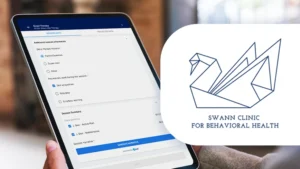Written by Rick Kubina
Do you, someone you work with, or person you care about, engage in practice? If I had to guess I would say yes. People use practice to get better at all sorts of things.
In business, you might find people working at call centers practicing how to respond to specific questions. At the prestigious Weill Cornell Medical College, medical students, surgeons, and other healthcare professionals practice safety procedures in their Skill Acquisition and Innovation Laboratory. In sports, basketball players practice free throws and intricate plays. And in schools, students practice math facts and writing descriptive paragraphs.
If people want to get better at a skill they can do one thing only: practice. But differential outcomes occur depending on what goes into the practice.
Figure 1. A picture of the Skill Acquisition and Innovation Laboratory.
You can find much written about practice. The legendary coach John Wooden has emphasized the absolute necessity of practice in developing masterful skills. Wooden said, “I am not a strategic coach; I am a practice coach.” Hard to argue with a person that produced a head-shaking 10 NCAA national championships in a 12-year period (he had a stretch of 7 championships in a row. I mean, who does that? Imagine someone winning 7 Super Bowls in a row or 7 World Cups in a row!).
Iconic athletes such as Michael Jordan, Tiger Woods, and Tom Brady all have publicly shared their secret to success – practice. The famous hockey player Eric Lindros said, “It’s not necessarily the amount of time you spend at practice that counts; it’s what you put into the practice.”
Yet for all books written and anecdotal stories shared from people who have mastered their domain, people oftentimes miss the three fundamental features of superior practice.
1. Timed practice trials
No one can escape the universal fact that everything people do, they do in time. By using a timer, we place brackets on the practice segments we choose to observe. As a result, we can compare apples-to-apples when we scrutinize the performance data. Examine the following practice scores for a group of students doing letter sound fluency:
- 13 correct
- 15 correct
- 18 correct
- 20 correct
Would you conclude the practice procedure worked? The data above sure tell us so.
Take a second look at the data in time:
- 13 correct in 30 seconds
- 15 correct in 40 seconds
- 18 correct in 50 seconds
- 20 correct in 60 seconds
What do you think now? When we place data on the Standard Celeration Chart, a chart designed to show human behavior in time, we see a drastically different picture.
Figure 2. A portion of a Standard Celeration Chart showing practice with letter sound fluency.
The data actually worsen across time because while the total number goes up, it takes longer to achieve the letter sounds. Ignoring time invites misleading data into the decision making process.
2. Commit to a daily number of practice trials
Systematic practice has three terms pertaining to a practice routine:
- (Practice) Schedule: Planning and scheduling of daily practice sessions.
- (Practice) Session: Overall length of the time spent practicing. Includes all elements of practice.
- (Practice) Trial: An instance of one timed application of practice.
Let’s examine the well known athlete: Olympic swimmer Michael Phelps.
Figure 3. Michael Phelps doing his thing.
Each day Phelps schedules his workout routine to include strength training, cardio, and practice on specific skills.
During a Tuesday Phelps may workout and have a practice session scheduled for the day. The session involves all the daily targeted practice activities. Two of Phelps practice activities:
- 500 strokes (50 kicks – 50 drill)
- 2000 timed kick stroke
Focusing in one practice activity, we see Phelps does four trials of speed sets (24 X 25 fly on 30 minutes).
Order emerges from Phelps practice regimen. He has days where he schedules his practice, sessions where he designates his multiple practice activities, and a set number of trials for each practice activity.
By keeping track of how many practice trials a person engages in data emerges from each timed trial. If performance does not improve many options now exist. One could increase the number of daily timed practice trials to see if a positive change takes place. Or someone can implement specific feedback within each trial with the resulting data showing whether the new feedback improves performance.
Failing to keep track of the number of daily trials means less information for situations where performance does not improve. Additionally, science demands order! How can we replicate skilled improvements and excellent feats of behavior without knowing how much practice someone must engage into to acquire said skills?
3. Provide feedback after the practice ends
With all the people that golf as a hobby it is a wonder why everyone can’t make the pro tour. But just because someone does something a lot doesn’t mean they will get better.
Reading the scientific literature reveals practitioners and researchers equating practice with going faster or doing more repetitions of a behavior. Effective practice, however, requires the addition of performance feedback. The feedback drives improvement so the next time the persons practices the targeted skill improvements may occur.
With golf, hitting more golf balls or hitting golf balls faster compared to game time won’t correct a slice or hook (for those not familiar with golf, a slice and hook describe the ball traveling in a hard right or left motion).
When providing practice, coaches or those invested in helping others improve through practice can deliver affirmative feedback (e.g., You hit the golf ball straight), inspirational or motivation feedback (e.g., Fantastic job, you played your scales beautifully), or corrective feedback. Corrective feedback can take three different forms:
- Saying how to do something correctly
- Modeling how to do something correctly
- Guiding a person doing something correctly
Conclusion
Many proverbs, quotes, and phrases stress the vital importance of practice and its outcomes. For example we have all heard the old adage “Practice makes perfect.” Stated differently, to attain excellence at a skill, people must practice. And all practice routines will improve by timing the practice trial, having a set (adequate) number of practice trials completed each day, and providing performance feedback.






